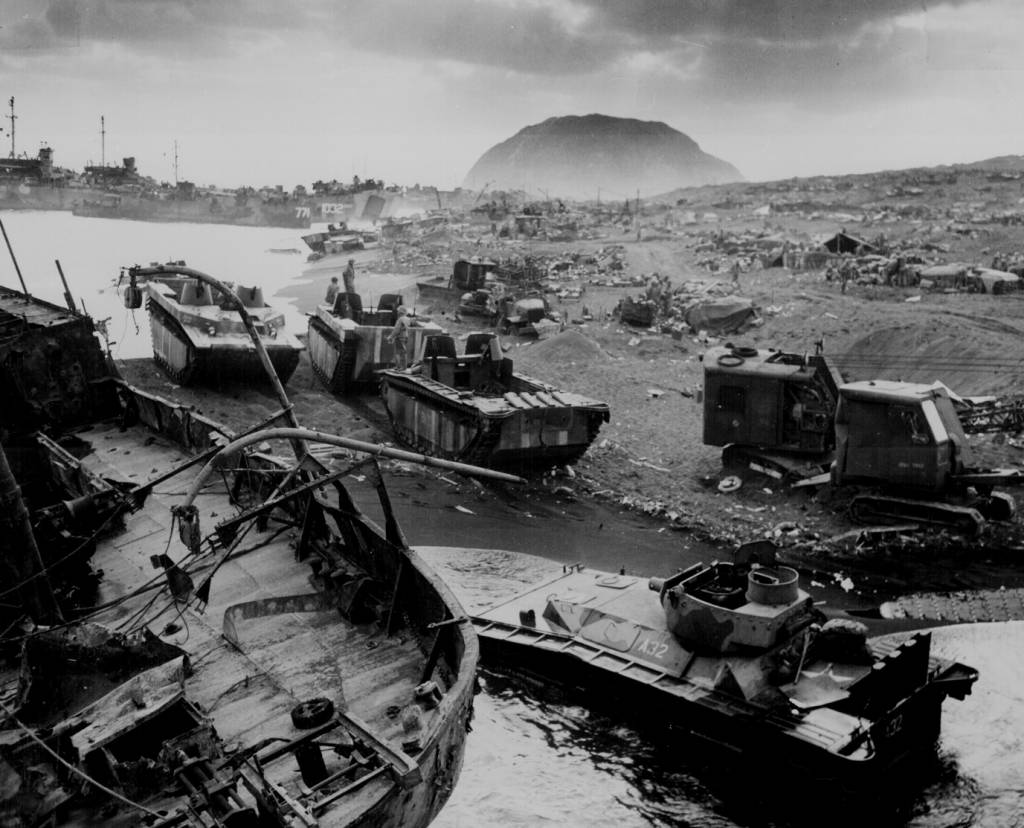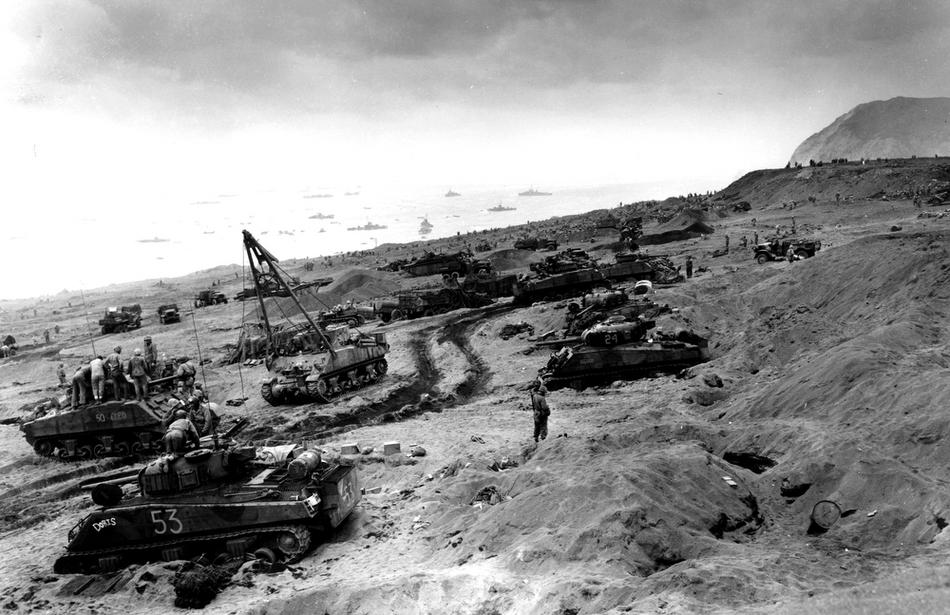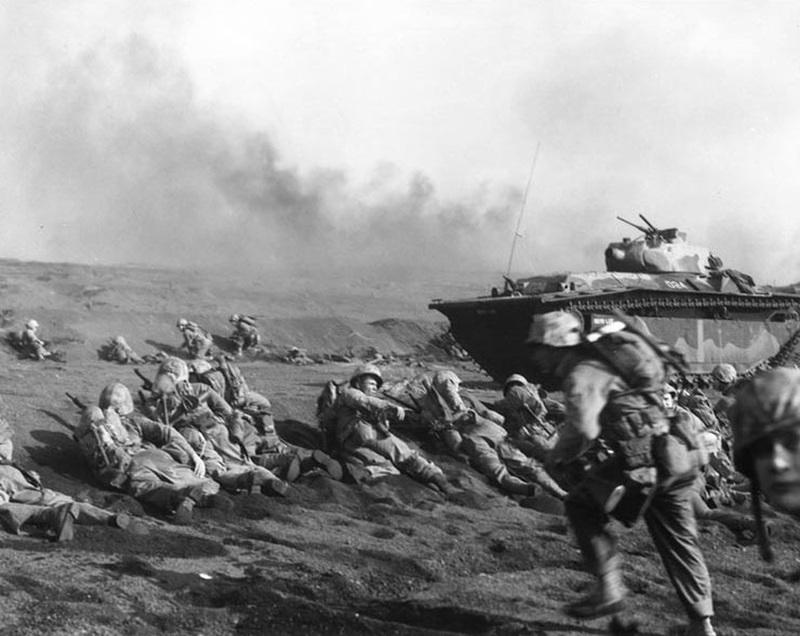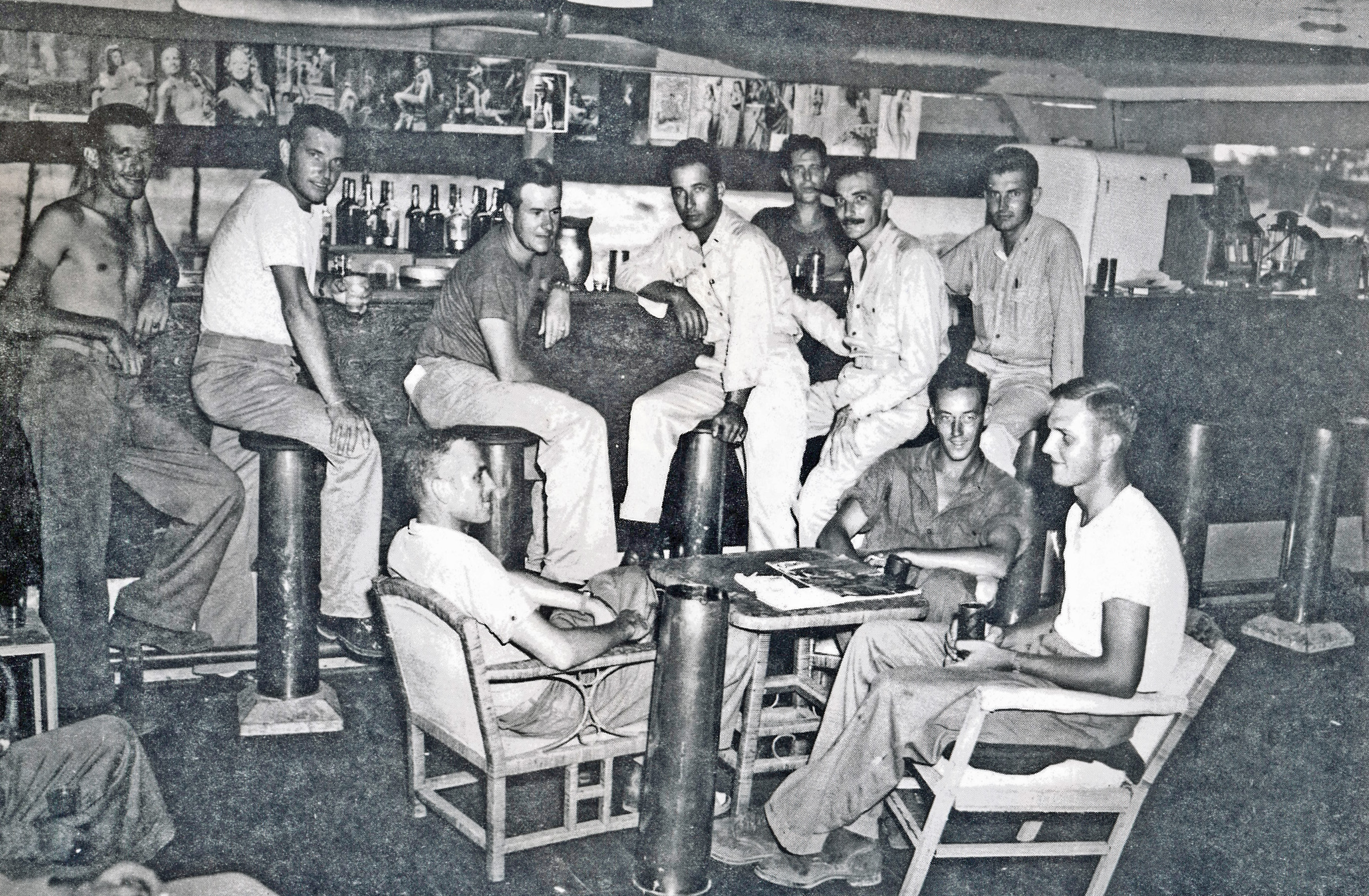THE BATTLE FOR IWO JIMA
REST, RECREATION AND TRAINING ON SAIPAN WHILE AWAITING IWO JIMA.
After the battle for Tinian, the battalion returned in stages to Saipan for rest, rehab. and training. H&S Company returned Aug 2 & 9. A Company and B Company arrived Aug 12th and 11th, respectively. C Company landed Aug 6th, 9th & 12th. D Company came in Aug 6th & 11th. The battalion's sick and wounded returned during the Tinian Campaign.
MARSHALL A HARRIS: During the Japanese counter-attack that first night on Tinian I either fell or got blown off our amtank. I can't remember exactly. But I recall going topside to help Norm Slowe up in the turret with his eye put out and remember flares overhead then a sudden white blast. Maybe stumbling backward then I fell off onto the the reef. Its rough coral sliced my leg up to the knee. Plenty shook up I scrambled back aboard. After the firing stopped and the sun rose and we got Slowe to the first aid station just south of White Beach 1, Pappy patched up my leg and we took off down the island. For several days we drove south with the land tanks and it wasn't until we'd gotten past Tinian Town that, too weak to climb out of the amtank for the night, I just slouched there inside. Next morning I was delirious. Pappy cut off my trousers to find a swollen and hideous leg streaked with reds and purples. I recall getting strapped onto a steel cot fixed into place over where the Jeep's passenger seat had been removed then later being lifted on the cot up into a A-26 Bomber, a black bird with single tail, and on the flight somebody saying the Japs were shooting at the landing craft going back to Saipan with the wounded, so they were flying me over. That's all I remember until waking up in the hospital there next of the big airfield down south on Saipan. I lay there several weeks. The Marine on the bed to my right would puff on cigarettes and blow smoke out the hole in his chest where he'd been shot. We all though that was funny, and he acted disappointed when finally he couldn't do the trick because the hole in his chest had healed. War does funny things. Sometimes all you can do is laugh and joke. Losing all my tan, I'd turned white as a ghost before I was able to walk out of that place. All I wanted was to get back to my buddies. The first day I could walk I snuck off at 1 a.m. and hitched a ride with a sailor in a navy jeep headed north to Tanapag Harbor. He dropped me off half way there in our camp. I slept on a table in one of our Battalion's mess halls. Next morning I found my amtank crew's tent. What a reunion! Losing my crew was my biggest fear back then. Sticking together was key, we all felt that way top to bottom. Likely that's why I didn't report my leg injury. Nothing seemed worse at the time than being taken away from my crew mates.
Note: Building the battalion's R&R camp on Saipan began August 7 1944, our home until we left in February 1945 for landing on Iwo Jima.
C. J. EVERS - COMPANY B: Before the SeaBees built our campsite on Saipan, each amtank commander was told to find a suitable spot to house his amtank and crew. I spotted an abandoned farmhouse on the hillside. We searched it for booby traps, and found none. Its roof was intact and its floor in fairly good shape, but two walls were missing. A shed at one end of the building housed our amtank and we set about cleaning up the place. Bananas hung off a tree just outside. After a few days we had ripe bananas with our breakfast cereal, and a chicken wandered into our camp. My men saw the bird as a chicken dinner. I saw it as a mature hen and told them to hold the chicken dinner, maybe she'd lay some eggs for us. We made her a nest in the shed and fed her scraps and crumbs of our own food. She found the nest to her liking and soon laid an egg each day for our breakfasts. I don't know what happened to her after we moved to our new tent-homes, but I wished her a long happy life.
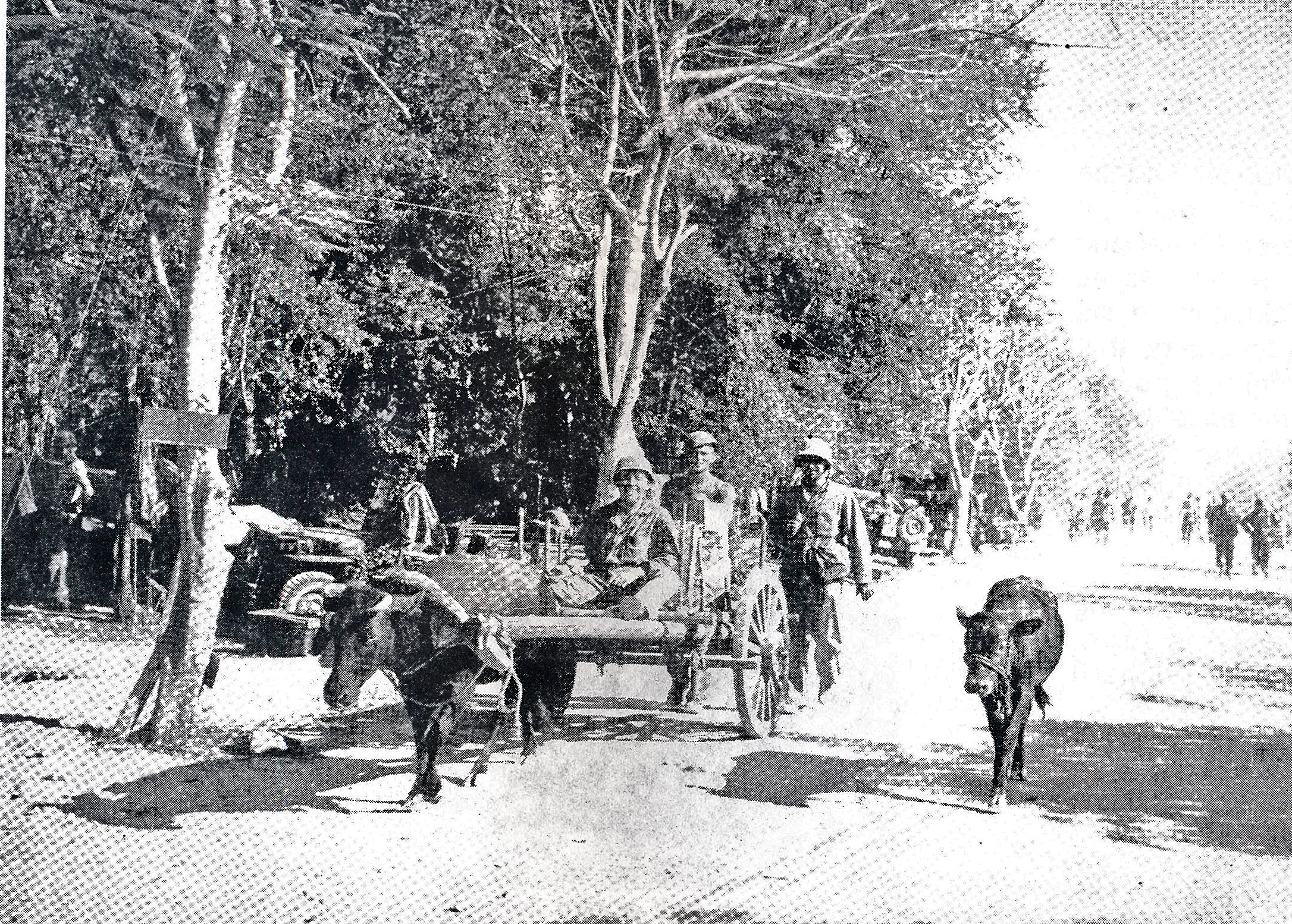
In Photo Paul DeVaul of B Company goes shopping for "goodies" with his retainers "Red" Jones and Art Auxer trailing behind his "carriage".
VERNON C. LOWE - H&S COMPANY: Before our camp was built our companies were spread out between Garapan and Charan-Kanoa. Each company had its own mess kitchen. Our cooks did a darn good job with what they had early on. The 1st 30 days was Spam. The next 30 included Vienna Sausages and canned fruit we "requisitioned" from the Army Depot. Never tasted spam and Vienna Saugages fixed so many ways.
CHARLES H. ORLOSKI - H&S COMPANY: My diary entry on August 7 said: We began building our new camp on Red Beach 2 and Green Beach at the Airstrip before our people returned from Tinian. I caught Denque Fever, sick for 5 days. We had three air raids between August 12th and 19th.
One day we went up to Tanapag Harbor, where Oliver Kennedy and I noticed Army jeeps with trailers lined up on the dock after being unloaded from a ship. We sauntered over, got in one, started it, and decided to borrow it. Going back to camp we stopped at a SeaBee Base. There we talked the SeeBees out of some paint that we slopped on our Jeep, turning it into a Marine Corps vehicle borrowed from the US Army to deliver mail to our Marines. Soon thereafter we headed back at Tanapag Harbor on a special mission handed down by our higher ups. At the dock we maneuvered our trailer under a ship's cargo net offloading cases of Papst Blue Ribbon Beer. We took on the full load of beer and headed for the SeaBee base where we offloaded half the beer to those guys. This did the trick. The next morning SeaBee trucks arrived at our camp loaded with building materials and SeaBees built wooden decks under our tents and showers for our entire Battalion's tent city.
VERNON C. LOWE - That shower system was special. Long 2.5 inch pipes ran from H&S Company's water tank down our camp streets, feeding 55 gallon drums that served showers placed along the rows of tents, including D Company.
REED M. FAWELL, JR: General Thomas E. Watson, Commanding General 2nd Marine Division, and his Chief of Staff Col. Shoup inspected our camp site early on. On their departure I heard the General ask Col. Shoup where had "Fawell got all his tent decks? His is the only Marine unit with such comforts."
Turning to me, Col. Shoup said: "The General wants an answer."
"From the US Army Dump, SIR, "I replied to the General.
"That is alright" said General Watson. "You take care of your Marines."
I did an about face, went to our bar and had a beer. (Note: General Holland "Howling Mad" Smith helped facilitate the Colonel's procurement of the wood tent decks and showers for his Battalion.) One of the 2nd Armored Amphibious Battalion's bars was found in the Battalion's Officer's Club:

Left to right G. F Crump, Bn Adj., R. H. Pratt, A Company CO, C. F. Ambrose , D Company CO, J. W. Simmons, Bn Comm. officer, C.L Morrison, C Company Maintenance officer, C.E Bogert, Ass't Bn. Comm. Officer.
JAMES A (AL) SCARPO - COMPANY D: General Watson also paid the Battalion's Maintenance Section a surprise visit. The road between Garapan and Charan-Kanoa ran past our maintenance tent, a jerry rigged affair covered by a canvas tarp that we had draped over horizontal two-by-fours that we'd suspended some seven feet up off the ground. The tarp kept dust off the tank engines we were overhauling. One morning Kenneth Sweet pulled the tarp back off a long stretch of two-by-fours then climbed atop the narrow two inch edge of the boards, and started doing a jig on a high wire, moving to his own cadence atop the boards ... Rip March One, Two Three Four ... Rip March ...
Unbeknown to the dancing Marine , a jeep flying a star flag pulled over. I saluted the General's Flag.
"What's your rank?" demanded General Watson, stepping from his jeep.
Sergeant of Maintenance, SIR, I replied.
The General looking up at the dancing Marine amtank mechanic asked me: "Where's your Officer in Charge?"
"He's not here right now, SIR," said I.
The General gave me a strange look and then want to know "What we needed?"
"We're short of most everything around here" said I.
"Make out a list then and get it to me", said the General before he looked back up at Sweet, the still dancing Marine Amtank engine mechanic. "Sergeant, are you sure that there is nothing wrong with that man?"
"No SIR, there's nothing wrong, SIR".
The General shook his head and I saluted as the General climbed back into his jeep and left. I've often wondered years later what General Watson was thinking as he was driven off down the road in that jeep. It turned out the General couldn't get anything Colonel Fawell couldn't get.
(The Battalion's camp on Saipan was built 200 yards inland at the boundary between Red 2 and Green 1 landing beaches. This site was near the 2nd Marine Division cemetery, and the tent camps built for the 2nd and 5th Marine amtrac battalions. The Battalion's vehicle park with maintenance and repair facilities were along the beach and just behind it. Tents were build on wooden decks. 55 gallon water drums served the men's showers. Railroad ties from the Japanese small gauge railroad served as structural supports for Mess Hall shacks under canvas cover. Five or six Marines bunked in each residential tent flanking both sides of the grid of Company Streets laid out in parallel lines. Each Head comprised three drums. These were sunk in sand, each to a different level, the highest named HIGH POCKETS, the lowest named STUMPY, the third labelled NORMAL. Each cot within all tents was served by Mosquito netting mounted on four round sticks upright at the four corners of each cot. Each tent's center poll tethered personal items. One tethered a pet money abandoned by the Japanese.)
G. MILTON SHIRLEY - COMPANY D: I helped construct our Enlisted Men's Club and our entertainment stage. I also built the barber chair for our Company Barber Simon Miller. I got his first haircut in that chair. Would you believe it, the rascal charged me a quarter for it! Captain Thobe asked me to be the Company Barber after our original barber got wounded on Saipan, said SIMON MILLER.
ART L. HOLMES - COMPANY D: Sergeant Pickrell said we should build a radio repair shop big enough for two of us to sleep there. We got permission for an enlarged space and then had plenty of help from many friends, including our Company Carpenter PFC Shirley. We salvaged our building materials from Garapan and soon had built a place big enough for our after hours "Poker and Bridge Club."
CORNELIUS J. VANDERKOLK - COMPANY C: One day Colonel Fawell told me that the "The Division" wanted to know if we could hit anything with our amtank's 75s mm Howitzers and for me to get a crew. I rounded up the crew for Amtank Shanghai-Lil and soon Harold Rosvold was driving Shanghai-Lil with its gunner Carlton "Eel" Evans riding up in its turret following the Colonel's jeep to a light plane landing strip at the island's far end. At the appointed place the Division Officer told us to pull around a hill until a tree came into view at the far end of the field then to immediately fire, trying to hit that tree. Rosvold coming round the hill spotted the tree then slammed on the brakes. Dust flew as Gunny Evans let one go that blew off the tree about 3 feet from the ground. Cool as could be Evans, looking down from the turret, asked the Division Officer matter of factly: "Want me to blow out the Stump?"
What a shot! Luck? Who knows? But we got a lot of free beer for that one
HAROLD ROSVOLD - Driving Shanghai-Lil at the time, I remember "Eel" slicing that banana tree off, leaving only its stump then asking "Want me to blow out the Stump?" before he fired off another shell blowing out that stump too.
"But we got a lot of free beer for that one." Seated on stools left to right: Sid Cram, William Egan, Reed Fawell, Harry Sidhu, Thomas Simmons, and John Williamson. Left to right at table: Howard Homes, Charles Bogert, and C. J. Vanderkolk. Photo taken in 2nd Armored Ampibious Battalion's Officers' Club on Saipan.
Crew that fired THE SHOT Heard Round the World
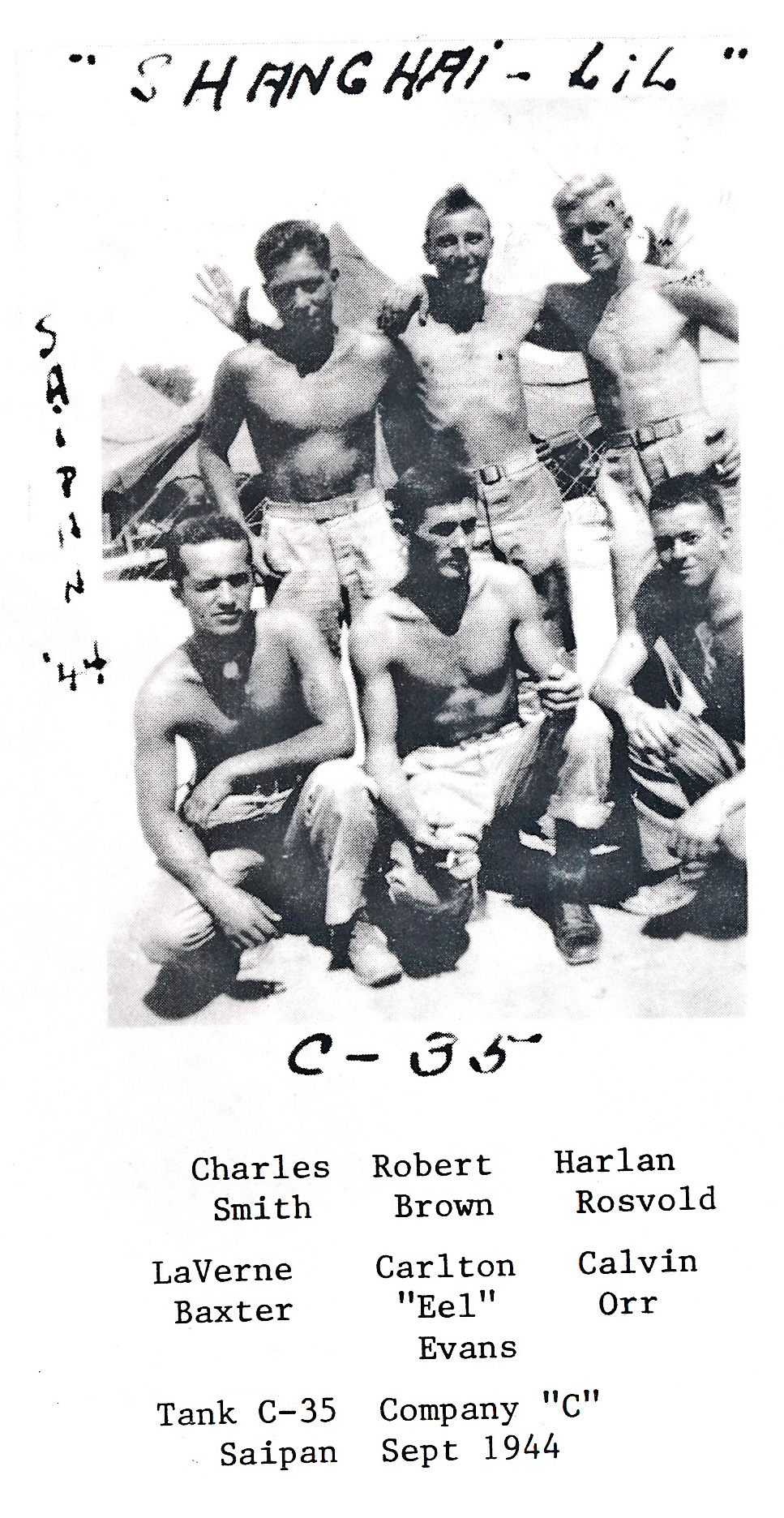
M. NEIL MUMFORD - COMPANY A: We had a very gifted bunch of maintenance men. They did many fine things, among the most amazing things were our windmill washing machines they fashioned from 55 gallon drums and showers created out of Jap truck beds. They made our Mess Hall out of railroad ties that they covered with tarps. I also recall that we worked for several days cutting down trees and smoothing out the land for the site of our camp and only THEN did they bring in the bulldozers for us.
REED M. FAWELL, JR - BATTALION: Our maintenance people could do anything. One day, walking into our Battalion Dental Tent, I saw the Dentist's Corpsman peddling a bicycle like contraption hooked up to Dr. Supples tooth grinding machine. Later our maintenance people replaced the pedals with electric power that was more effective but their initial "Rube Goldberg" was far more inventive.
HERB CRACRAFT - COMPANY A: I remember the gallons of orange marmalade and hard candy on the mess tables all the time ... and the gasoline tank truck showers that we made ... and the 1944 Christmas Eve night on Saipan ... and watching the native girls go by from work to the stockade ... and being allowed to go aboard ship and get a fresh meal.
ORIE F. MORGAN - COMPANY B: Most every day Marine patrols would go up into the mountains and jungle ravines and caves to "weed out" Japs that came down to harass us at night. Some were well armed and loaded with ammunition. Many small battles were fought. An official Marine Corps photo showed a group of Marines, including myself, saying "good-by" to buddies just killed in one of these battles. (Photos with captions to be inserted.) (see Charles Cuilla's below comment on Jerry Brooks.)
At considerable labor men from the battalion cleared a baseball diamond. Their team won 28 straight contests, the undefeatd Saipan Championship Team. The Battalion Boxing team also prevailed over all other Battalion Teams on the island. Formal contests called Smokers were held Friday or Saturday nights, using 8 ounce gloves (although 10 and 12 ounce gloves were used for intramural training). Winning fighters got a $25 prize, the loser a case of beer. Wagers changed hands at these Smokers, and over-confidence crept into the those wagering on 2nd Armored Fighters. Hence the 2nd Armored pugilists went up against the Regimental Boxing Team of the 2nd Marine Division, lost every fight, and substantial sums left Battalion coffers. The blow-out proved memorable on a number of fronts.
RICHARD W. MASON - COMPANY C: The boxing team started after we made a heavy punching bag that we hung on a papaya tree at the end of our Company's street. I recall some of the guys doing a little boxing included Buckley Pudwell, Carlton "Eel" Evans, Joe Bishop, myself, and Jerry Brooks before we set up a formal Battalion Boxing Team. John Cawley was its coach, Lt. Vanderkolk his assistant.
CORNELIUS J. VANDERKOLK - COMPANY C: John Crawley coached the team and I helped a little. I recall Louis Tapio, Jerry Brooks, Charley Strachan, Richard Mason and Joe Kupiec boxed for us. One night, when our team went to the far end of the island for a big fight program against an entire Regiment, we didn't fair so well. Tapio got his mouthpiece lodged in his throat. Crawley had to jump into the ring and dig it out with his fingers to keep Tapio from choking to death. Going back to camp that night was dark and raining. Everyone was soaked miserably. Nobody said a word. Then Tapio blurted out "This beer is getting mighty expensive." Each fighter who lost got a case of beer. A $25 war bond went to every winner. Until then all of us had been winning a lot of fights. So much so that Brooks worried that his dad might find out how he was getting all those $25 war bonds that he was sending home to his mom. His dad thought boxing was too dangerous. The Armed Forces Radio carried sports news items and the word on Brook's success in the ring did filter back to his dad after all.
JERRY BROOKS - COMPANY C: Our coaches Cornelius Vanderkolk and John Cawley were Company C Platoon leaders, great guys and two of the best combat officers in the Marine Corps. None of us had seriously boxed before. We did our best, had a lot of fun and won all but one of our team matches. A $25 war bond was sent home for you if you won. A case of beer came your way if you lost. My long arms kept me out of any serious trouble during my initial fights and I got pretty cocky. (Jerry Brooks was also 6 feet 4 inches tall). Our guys began to bet a month's pay on these fights. So winning got important. But the beer came after we fought a 2nd Marine Division Marine Regimental Team, said to have fought for money before the War. In any case, we lost to a man. It wasn't close either. My opponent didn't blink, or duck, just slipped my jabs and came back at me lightening quick, whacking me with flurries. I kept bicyling backwards and slipping out of the corners and he threw nothing that could put me down or out. By the end of match he was very mad with me still standing, although I'd lost on points. In the dressing room he insisted on a rematch. There wasn't enough gold in Fort Knox for that. Fighting with 8-oz gloves, we were crazy enough to kill one another.
HAROLD ROSVOLD - COMPANY C: Jerry Brooks was deeply religious, so much so that when he knocked a guy down boxing, he'd go over, apologize, help the guy to his feet, and then more than likely knock him down again. Carlton "Eel" Evans was another fine boxer. Pound for pound the "baddest" toughest guy in our company, "Eel" took the Regimental boxing Championship on Saipan in his weigh class. His idea of an exciting Sunday afternoon was grabbing a bandoleer of cartridges, a few hand grenades, his M-1 rifle, and Jerry Brooks. The pair of them so armed would go off into the hills hunting Japs. Tall and rangy, an excellent athlete, Jerry Brooks when not exercising spent his leisure hours reading, writing, drawing, or playing his harmonica. A very serious minded guy, he also loved collecting Jap memorabilia - swords, flags, bugles - and the bugles he played quite well.
CHARLES CIULLA - COMPANY C: Jerry Brooks did a lot more than box during our R&R on Saipan before Iwo. For months after the island was declared "secure" Japs still roamed the ravines causing trouble. On Sundays Brooks came by my tent saying "I going up into the ravines to hunt Japs, you coming?" That was Jerry. The Japs did more than trying to kill us in the ravines. An air attack caught us out in the open one cloudless moon lit night. Unable to reach an air raid hole, I took cover behind a sand barrel near our baseball field. Ducking behind it I saw the Jap gunner clear as if he was posing for a picture. I got off one shot, sort of quick like John Wayne, likely missed him by several football fields. His plane had passed over and was gone when I discovered the sand barrel was empty. Later Jap Betty Bombers came low over our camp and caught us running to air raid shelters. John Bistline, a really nice guy from Shulavista, Utah, was 20 feet behind me when he caught what likely was a 40mm shell. Instantly Lt. Vanderkolk was there without shoes, just in his shorts, ignoring stuff flying about as he tried to help by stuffing bandages in the wound. But it was too massive, yet like always Lt. Vanderkolk's efforts were great. We all loved Lt. Vanderkolk. He was the best Lieutenant in the world!
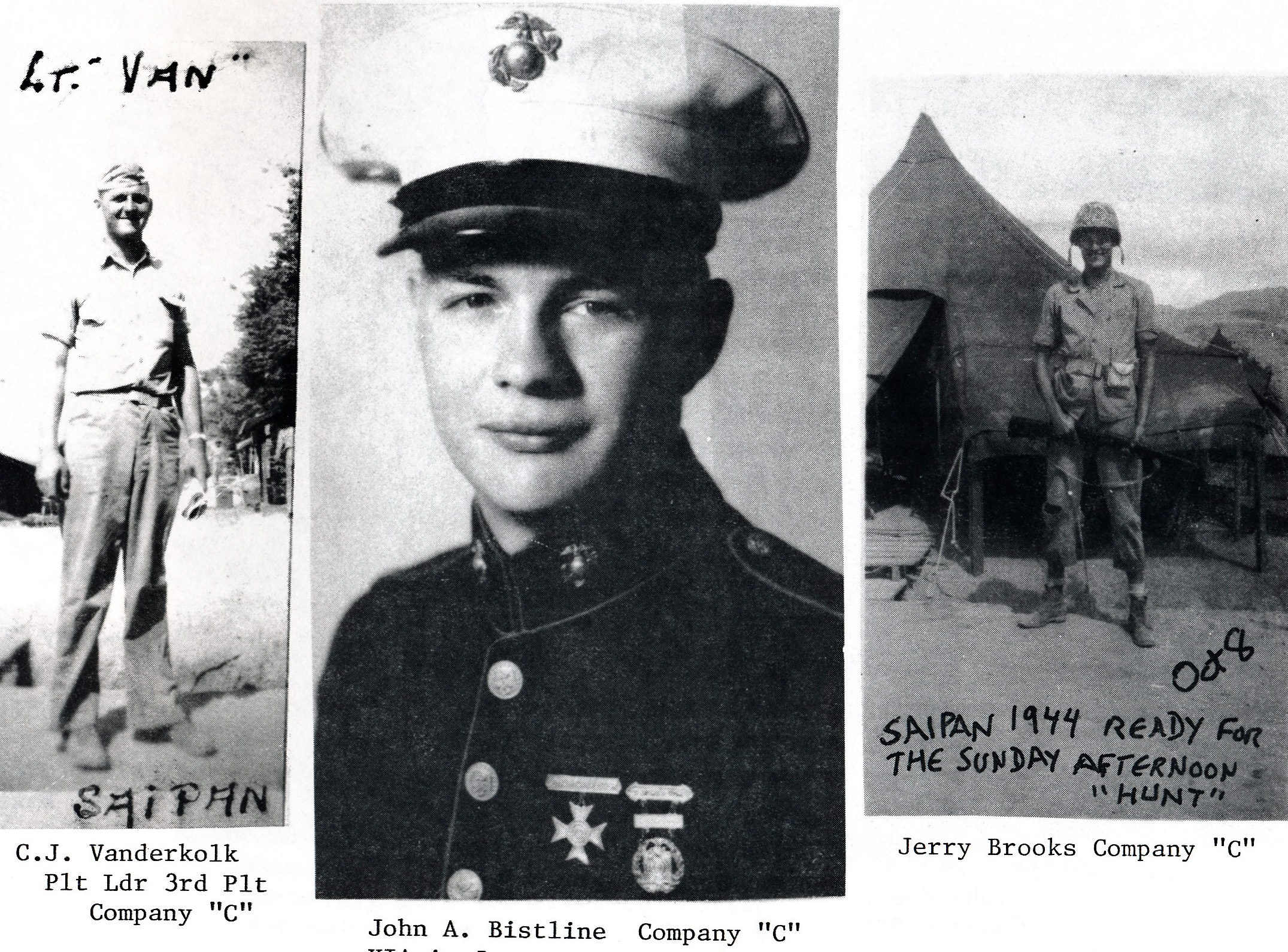
BILL LUC - COMPANY B: The same thing happened of us, the Jap planes straffing us before we could get across the baseball field. Once guys were diving under 2nd base for cover at the same time, but none got hit.
L. H. VAN ANTWERP - COMPANY C: Jap air raids came mostly at night. Even during the day they might catch us lined up for chow. Our Company Dog we named FOXHOLE. In our maintenance shop on the beach we used an MT Wrecker to remove engines and "A" frame for heavy lifting. Our Lo-Boy truck carried amtanks on land. A new set of amtanks arrived after Tinian with plenty of time to get them ready just the way we wanted them before our next battle. We put on better and more armor in key places. Some amtanks we outfitted with a 2nd machine gun swivel mount on the turret's right side, adding it to the one on the left side. We'd learned a lot from our first battles so changed a lot of small things that counted in combat when the chips were down. The Japanese were good teachers, we were quick learners.
R. CARL SCHMIDT - COMPANY C: While fixing up some tanks my clothes caught on fire. Jim Mackey rescued me. Still I spent nine months in hospitals in Hawaii, San Francisco, and Great Lakes. JOE KUPIEC - Mechanics washed their clothes in gasoline then rinsed them out in water to get the gas out. The clothes came out clean. Laying on the grass one day I heard a scream. Cpl. Bostion was on fire. I grabbed a blanket and covered him with it. It worked, not a burn on him. The earlier washing hadn't got all the gas out of this clothes, so walking past a fire he burst into flames.
B. G. THOBE - COMPANY D: Fire was a constant hazard. Our Maintenance Officer Lt. Basil Godbold scrounged Jap boiler plate that our Blacksmith cut into 12 inch strips that he heated in a forge then rolled into .25 inch strips that he hammered into molten rings from which he fashioned layers of armored plate. One of his creations saved my life on IWO JIMA. Those rings welded into my amtank's turret stopped a 30 or 50 Cal. machine gun bullet dead in its tract a faction of an inch from the back of my head. Colonel Fawell had an official photo taken of the imbedded round and he signed it: Close but no Cigar! R. M. Fawell. I still have that signed photograph 45 years later.
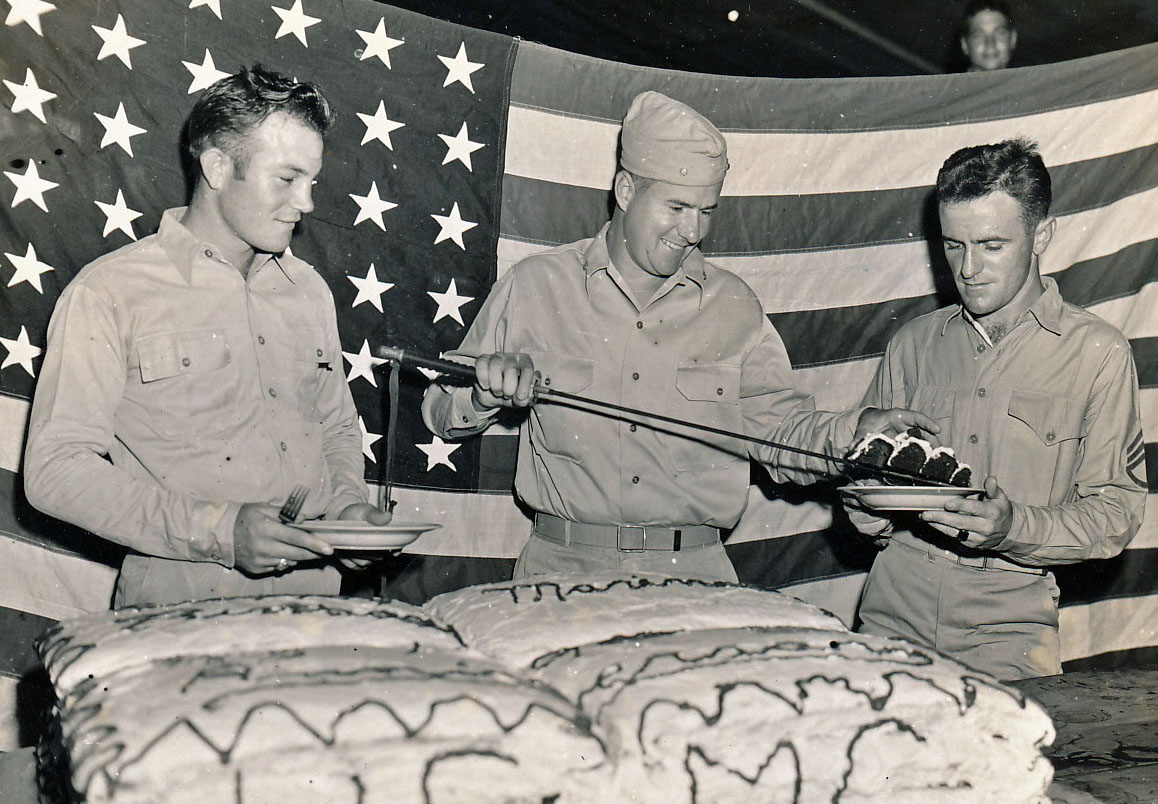 UNITED STATES MARINE CORPS - FOR RELEASE DP STORY NO. 12326
UNITED STATES MARINE CORPS - FOR RELEASE DP STORY NO. 12326
LET THEM EAT CAKE. Marie Antoinette's famous statement held new meaning in the Central Pacific on November 10 when Leathernecks observed the 169th anniversary of the founding of the Marine Corps by cutting huge slices of the best their mess sergeants could turn out. Lt. Col. Reed M. Fawell Jr. cuts the cake for his battation. The first slices went to Marine Sergeant Onel W. Dickens, 415 Laurel Street, Modesto, California, and to Marine Platoon Sergeant Benjamin R. Livesy, 355 South Main Street, Attlebarr, Massachusetts. (Official Marine Corps Photo by Sgt. M. Cohn III) (Note: Both Sergeants were recipients of A Navy Cross on Saipan.)
WINTON W. CARTER - COMPANY C: We lived in a tent city, had C rations and two warm beers a day after standing in line. Armed Forces radio beamed down from Mt. Tapotcahau. Air raids often at night. Training: Colonel Fawell and his Exec. Major Williamson are everywhere. "How's it going." Combat load. New Tanks, new Weapons. We get Tommy Guns and wrist watches and field glasses.
MARC (RIP) KOENIG - COMPANY D - Our battalion baseball team started with us playing catch with gloves and balls borrowed from the 2nd Amphibian Battalion that was camped alongside us there on Saipan. Hal Harrison, Dickey McCabe and I who'd played on Camp Pendleton's first baseball team in 1943 before we'd joined the 2nd Armored, came up with the idea of doing the same on Saipan. Doc Galuszka helped us start the team, and became a pitcher. After we'd played 10 or 12 games undefeated, the 2nd Division asked us to join their league. The ball park was next to the Divison cemetary. Many times we stopped playing on the sound of TAPs coming across the field. Japs shooting at us from the hills stopped one game. After the 10th Marines sent out a patrol into the hills we continued playing. The winning team of the league was supposed to represent the 2nd Division. But after we won all 28 games, becoming League Champions, the Special Services Officer of the 2nd Marine Division decided we weren't part of the Division, and refused to let us represent it. Instead, it was decided to build an All Star Team from the 2nd Marine Division on Saipan and the 3rd Marine Division on Guam while also giving us (2rd Amored Amphibian Battalion) five slots on the combined two division All Team. We were disappointed, having been through so much together.
As I recall our five players slotted into the All Star team were Hal Harrison (pitcher), Robert Robins (catcher), Wayne Terwiller (shortstop), Marc Koenig (second base) and Tom Foster (center field). We went to Guam for a week where the 1st Marine Division treated us very well with food, drink, and side trips round the island. The rest of our eleven man 2nd Armored baseball team were Mickey McCabe (3rd base) Albin Galuszka (pitcher), and outfielders Herb Egan, Bill Spenser, Eddie Kochmanski, and William Zack. The biggest thanks to our baseball team came from our own Battalion Officers in the form of a beer bust. Col. Fawell toasted us on a job well done in the name of our Battalion. There was plenty of good food and beer. We all really appreciated being a part of the great Battalion of Officiers and Enlisted Men.
WAYNE M. TERWILLIGER - COMPANY D - We played our early baseball games in boondockers so didn't manage to steal many bases but played well and won all our games, to become Saipan Champions. Undefeated we beat all the 2nd Marine Divisions teams. One unique thing about playing baseball on Saipan was play interrupted by air raid alerts. Col. Fawell and the battalion officiers threw a battalion party for the entire team before we left Saipan for Iwo Jima. Our Battalion had one of the best baseball teams in the Marine Corps during WW II.
(After the war Terwilliger played for Chicago Cubs, Brooklyn Dodgers, Washinton Senators, New York Giants, and Kansas City Athletics. After retiring as a player, he coached several professional baseball teams well into his eighties.)
ALBIN A. GALUSZKA. M.D - Our Battalion Baseball Team not only contributed greatly to the morale of our Battalion, its record - 28-0 - speaks for itself.
HEADQUARTERS, SECOND ARMORED AMPHIBIAN BATTALION, FMF, PACIFIC, IN THE FIELD
From: The Commanding Officer, and Officers, this Battalion To: Members of the Battalion Ball Team, Saipan island Champs
Subject: Beer Bust Tendered by Battalion Officers
1. You are cordially invited to attent a Beer Bust in your honor at 1850, 9 January 1945, at Second Armored Amphibian Battalion Officer's Club.
2. The Battalion Officers wish to express their appreciation for your cooperation and initiative.
3. Congratulations on your most successful undefeated season of twenty-eight (28) straight victories.
R. M. Fawell Jr.
WALLY T. HILL - H & S COMPANY - Jap aircraft strafed us many times. We got strafed on a boat in Garapan Harbor. We got strafed watching an outdoor movie. We got strafed standing in chow lines. One of our C-47 flying off Tinian came in low over us with our AA shells bursting around it until it flew out of sight, leaving behind the AA flack that fell among us, clanking as it bounced off the steel decks of our amtanks. Several times we watched our new P-61 nightfighters splash several Washing Machine Charlies over the ocean. We'd tune into their radio frequency, listening to the action as we watched them battle. Around this time we changed our radios from Collins TCS AM types to Western Electric / Admiral 10 channel FM pre-tuned push button controlled.
I remember the Chamorros coming out of their barbed wire compounds every morning to do their field and garden work accompanied by several Americans carrying Tommy Guns. Jap military still up in the hills and ravines were a continual menace and constant threats. 2nd Marine Division patrols engaged in fire fights with these Japs on the hill side above our camp site. This was one way the 2nd Marine Division trained infantry replacements.
I also recall us going out into the Tinian channel on Higgin's Boats and climbing up cargo nets hung over the sides of our APA attack transports. This was a no picnic exercise. High swells often came at us just after we'd stepped onto the nets hanging down, forcing us to scamper higher to avoid getting smashed by the Higgin's Boat rising up with the swell coming up after us. Once we got atop the net, people yanked us over the side onto the decks of the APA.
KENNETH E. SMITH - COMPANY D - Just before leaving for Iwo we held maneuvers off Tinian. In rough seas I fell off our amtank and had to swim in. Fortunately one gas pellet was left in working order in my life belt. Sergeant Johnson and his crew came down the shoreline and picked me up. What a day.
HAROLD B. LITZ, JR - H & S COMPANY - After a Japanese bomber raid, Master Tech Sgt. Leo Hendricks hollered Shit! then headed straight to the beach where he charged fully clothed into the ocean up to his neck. Going for cover during the raid he'd jumped into a latrine slit trench, instead of his foxhole.
G. MILTON SHIRLEY - COMPANY D - An Army unit setting up camp a quarter mile away posted machine guns on their perimeter. When one went bezerk spraying bullets into a "John", Gunny Roberts charged out, stumbling over the pants he was trying to pull up, growling foul things about "Dogfaces."
AL ALVAREZ - COMPANY D - Via REMINQIA ALAREZ - AL made very special wine from potato pealings. It was so special, he often traded with officers his home made wine for their bottles of Whiskey.
ALBIN A. GALUSZKA. M.D - BATTALION - Once Col. Fawell and I took a trip over Pagan Island in a B-29. Our flight turned out to be most exciting when some Japanese fighters came up after us.
B. G. THOBE - COMPANY D - On Saipan we got to know some B-29 pilots. This included Lt Young who took several of us up for a ride one day in his B-29. We buzzed our camp then headed north for the Bonin Islands. A Jap plane jumped us. Lt Young put us into nose dive full throttle then headed for Saipan.
JAMES R. MCCARTER - COMPANY A - We were getting read to leave Saipan to go to Iwo Jima when Col. Fawell transferred me to H&S Company. The day before loading, the Colonel told me I was lucky because there was no room for our motor transport on the ships assigned to our battalion, and quickly added "you may not have it so easy because I'm appointing William Peck CO of the rear echelon and you'll be his executive officer. Your main objective will be to build us a campsite while we are gone." By the grace of God and help from the SeeBees we got a beautiful camp built, one with wood frame and flooring for our tents fronting coral streets. Then "Behold!" The Colonel sent us a telegram saying the LSTs were coming to pick us up to join our battalion back a Maui!
SECTION is being built and edited daily as APRIL, 2015, Incl. Photos.
SAILING FROM SAIPAN TO IWO JIMA
The second Armored Amphibian Battalion boarded 20 LSTs and 5 APAs on 11 February 1945, departed Saipan on 15 February, and arrived off Iwo Jima in the early morning hours of 19 February, 1945, as part of the 485 ships of Task Force 51.
In transit, large relief maps were used in detailed briefings with all Marines. The large fold-out maps available were on the 1:10,000 scale and based upon "Photography from US Navy sorties flown on 19 August and September 1, 1944", some five and one half months before the Marines landed on Iwo Jima. These maps showed 34 "Defense Symbol Keys" comprised of hundreds of small black dots that altogether fairly covered the entire map. These hundreds of small black markings that fairly covered the map purported to locate guns, blockhouses, barbed wire, etc. in a profusion that nearly blotted out contour lines. Nevertheless, most Japanese firing positions and implaced weapons were never discovered until they were put into action against Marines after they had landed. All the maps showed high ground on both the left and the right of the landing beaches plus nearly solid black symbols showing gun positions that covering the landing beaches. These implaced gun positions on Iwo Jima resembled the enemy gun implacements on Saipan's Afetna and Mucho Points that had delivered flanking fire into the Marines landing on Green and Red Beaches there, so the Japanese on Iwo Jima also covered both flanks.
Very little was known about the diseases to be encountered on Iwo Jima. The worst was expected however. No really good estimates of the number of Japanese soldiers on Iwo Jima were available. There was also little or no information on the extent of deep underground excavations dug into the island to shelter the many thousands of undetected defenders from US bombing and shelling. Some US commanders thought this small island comprising 7.5 square miles might fall to the Marine assault in three or four days of heavy fighting as did Tarawa. Only three days of concentrated shelling was authorized to precede D-Day. Even then there was only one day of clear weather that allowed the full use of all weapons and ammunition allotted to the gunfire support ships. On February 19th the morning was clear and beautiful off the shores of Iwo Jima. It was Monday. The 2nd Armored Amphibian Battalion had completed its voyage to what would be its last and final battle in WWII.
EDITING OF BALANCE IN PROGRESS -

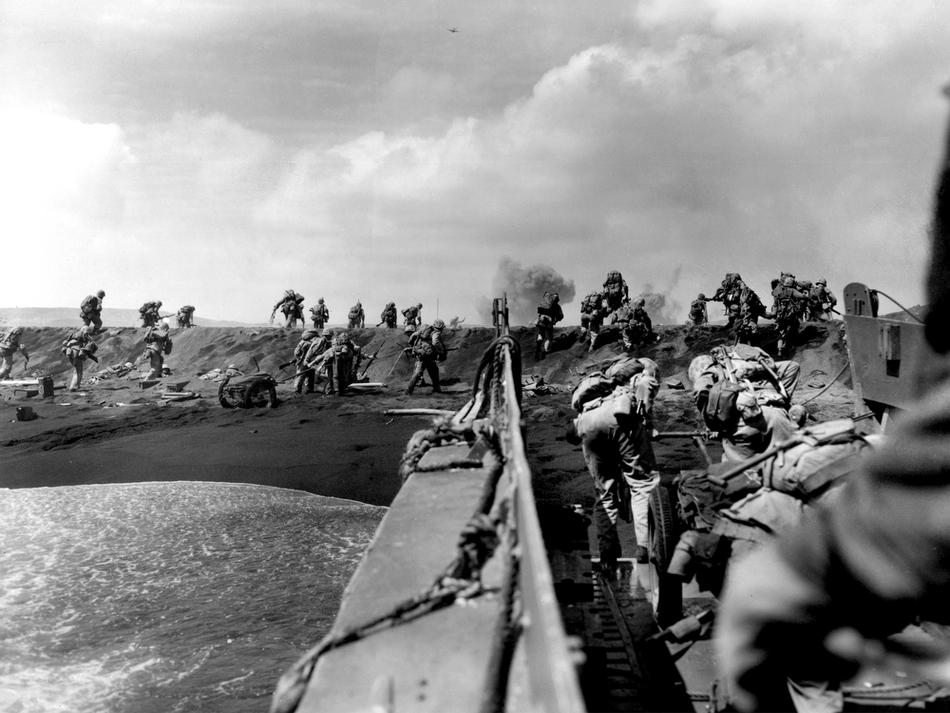
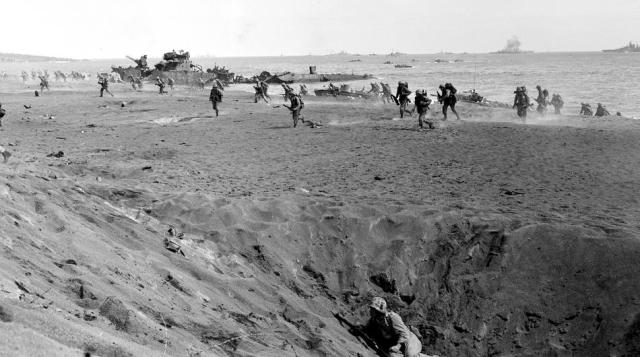

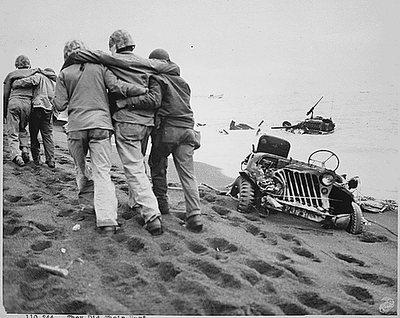
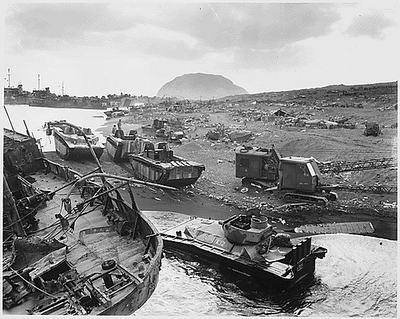


At Iwo Jima...
